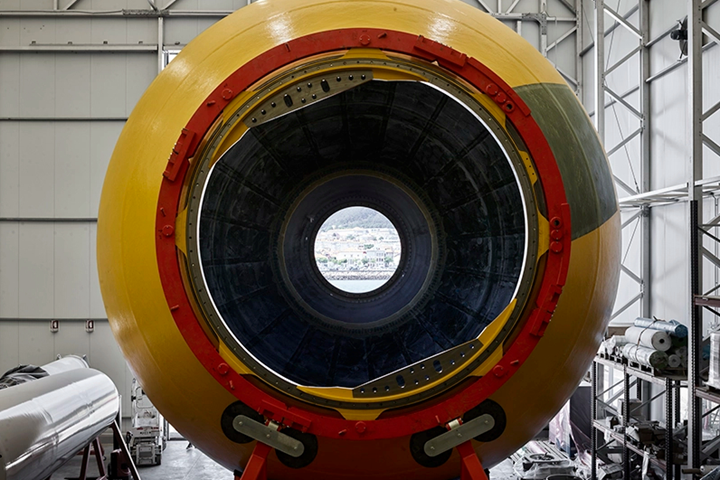CorPower Ocean delivers first commercial-scale composite WEC hull
Custom-built, environmentally controled workcell forms integral part of composite hull construction, will lead to future manufacturing scaleup and mobility.

Photo Credit: CorPower Ocean
CorPower Ocean (Stockholm, Sweden) has teamed up with composite machinery specialist Autonational BV (Iljst, Netherlands) and composite tank experts CPT Tankwell (Wieringerwerf, Netherlands) to successfully develop its first commercial-scale composite wave energy converter (WEC) hull in Viana do Castelo (Portugal). The hull is to be developed using a custom-built machine, installed inside an environmentally controlled workcell that will become the future regarding mobility and scalability of CorPower’s composites manufacturing capabilities.
The composite hull forms an integral part of CorPower Ocean’s next-generation C4 WEC which was recently unveiled at a global launch event in Stockholm.
Over the last year, process characterization work on quarter-scale models has enabled rapid iterations and continuous tuning to reach targeted quality and material properties reviewed by DNV (Høvik, Norway) as a certification body — paving the way for final commercial-scale construction, according to CorePower Ocean. Completed at the company’s Portuguese base in Viana do Castelo, it marks an important milestone in the flagship HiWave-5 Project, which will involve ocean deployment in nearby Aguçadoura.
Read more, “Industrial-scale wave energy system enabled by mobile filament winding.”
“This has been a tremendous team effort involving our specialist composite team in Portugal and Sweden with close cooperation with our local and global supply chain partners,” Miguel Silva, managing director for CorPower Ocean Portugal, says. “The C4 hull has been designed with a low-cost sandwich structure comprising filament-wound composite skins for the inner and outer layer separated by a core material. This approach brings a raft of benefits including high strength, durability and impact resistance combined with light weight and buoyancy performance properties, which can withstand fatigue, slamming and impact loads. Other important features include excellent adhesion strength and chemical resistance with low water absorption.”
The hull construction has been carried out in conjunction with dry-testing of CorPower Ocean’s power take off (PTO) system, using what the company says is the world’s largest wave energy test rig. In its entirety, the composite hull development workcell consists of a fully customized filament winding machine situated on a 14-meter-long base. This includes an automated carrying system to apply fibers onto a 9-meter diameter mandrel, to wind the hull layer by layer.
“Based on the R&D cell in Viana do Castelo, future versions of such manufacturing cells can be easily integrated in port or final assembly facilities, amounting to ‘mobile factories,’” Tord Jonsson, Supply chain and quality manager, says. “This will enable composite hulls to be built rapidly on customer sites, with additive manufacturing dramatically reducing lead times, cost and carbon footprint by eliminating transportation of the finished product. Delivering wave farms to our customers, we will be moving these factory cells from site the site, to produce the hulls needed for a project, then move the cells over to the next customer site. The equipment will be packed and transported in three standard containers, taking only a few days to assemble once delivered to a new site. Our ‘mobile factory’ concept enables high local content in projects, and will play a key role in revitalizing local port communities and local supply chains.”
Working in collaboration with several utility companies, CorPower Ocean’s first commercial-scale C4 WEC will be used to form part of a larger four-system array, and a wave farm generating energy to the national grid. CorPower Ocean’s CEO, Patrik Möller says the overall mission is to successfully introduce certified and warrantied WEC products to the market, making wave energy a bankable technology to attract mainstream renewable project finance and drive rapid deployment scaleup to address climate change.
Related Content
Plant tour: Joby Aviation, Marina, Calif., U.S.
As the advanced air mobility market begins to take shape, market leader Joby Aviation works to industrialize composites manufacturing for its first-generation, composites-intensive, all-electric air taxi.
Read MoreThe next evolution in AFP
Automated fiber placement develops into more compact, flexible, modular and digitized systems with multi-material and process capabilities.
Read MoreJeep all-composite roof receivers achieve steel performance at low mass
Ultrashort carbon fiber/PPA replaces steel on rooftop brackets to hold Jeep soft tops, hardtops.
Read MorePultrusion: The basics
A primer describing what pultrusion is, its advantages and disadvantages, and typical applications.
Read MoreRead Next
All-recycled, needle-punched nonwoven CFRP slashes carbon footprint of Formula 2 seat
Dallara and Tenowo collaborate to produce a race-ready Formula 2 seat using recycled carbon fiber, reducing CO2 emissions by 97.5% compared to virgin materials.
Read MoreVIDEO: High-volume processing for fiberglass components
Cannon Ergos, a company specializing in high-ton presses and equipment for composites fabrication and plastics processing, displayed automotive and industrial components at CAMX 2024.
Read More“Structured air” TPS safeguards composite structures
Powered by an 85% air/15% pure polyimide aerogel, Blueshift’s novel material system protects structures during transient thermal events from -200°C to beyond 2400°C for rockets, battery boxes and more.
Read More


























